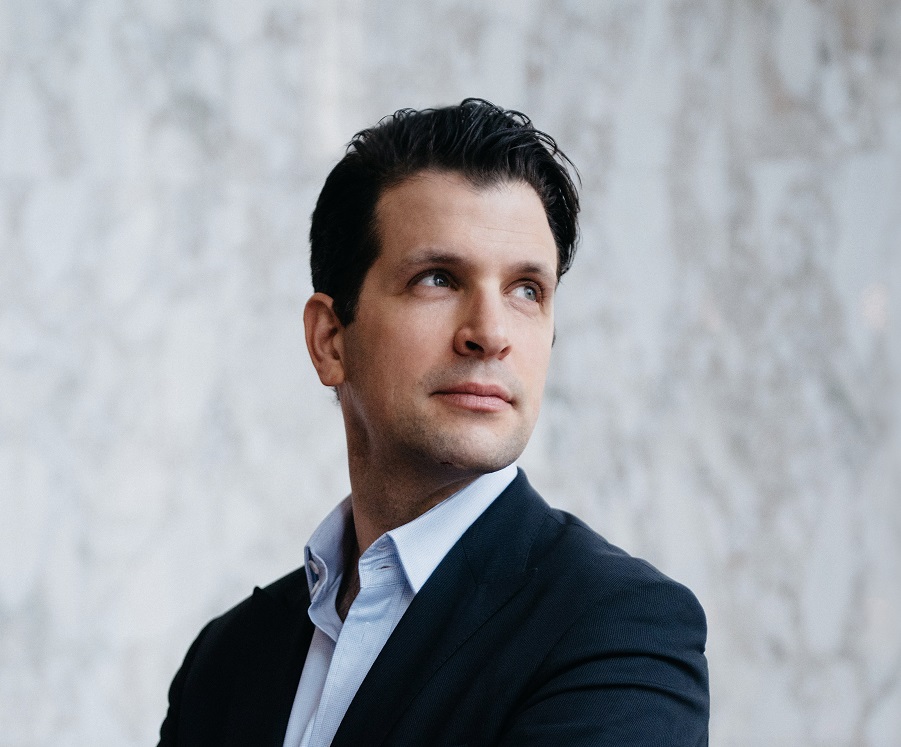Pisaroni goes beyond opera in streamed recital for Vocal Arts DC

Bass-baritone Luca Pisaroni performed for Vocal Arts DC. Photo: Jiyang Chen
Composers like Charles Gounod, Rossini, and Bellini may be best remembered for their operas, but their songs for voice and piano reveal some of their most sensitive and sophisticated inspirations.
For the last of its streamed song recitals before returning to the Kennedy Center Terrace Theater in January, Vocal Arts presented bass-baritone Luca Pisaroni and pianist Maciej Pikulski performing a selection of Italian bel canto and French melodies. Recorded in Vienna and streaming this week, the crisp recording ranges from gentle elegies to jaunty dances.
The effervescent lyrical trip begins with selections of songs from three Italian composers inextricably linked to bel canto: Donizetti, Bellini, and Rossini. These delightful bonbons would be common fare in 19th-century soirées musicales.
Singer and pianist closed a Bellini interlude with “Vaga luna, che inargenti” (“Lovely moon, who sheds silver light”) from his Composizioni da Camera, a collection of 15 voice and piano pieces that were only published as a full set in 1935, more than a century after they were likely written in Naples and Milan. The lines undulated like so many ripples on the water at moonlight. Eyes closed, palms facing upward in a kind of invocation, Pisaroni sang: “That a flattering hope / comforts me in my love,” repeating the line three times.
The contrast could hardly be sharper with Rossini’s melodramatic “Il rimprovero” (“The reproach”), drawn like the composer’s two other featured pieces from his post-operatic career following the successes of William Tell. Here and throughout the recital came highly sensitive playing and a deft touch from Pikulski. The Polish pianist kept flourishes in check, never overpowering his partner, even during Rossini’s idiosyncratic piano parts.
Pisaroni offered a bouquet of colors across the emotional arc of Rossini’s “L’ultimo ricordo” (“The last memory”), in which the composer inserted a personal touch to Giovanni Redaelli’s poem about a dying husband to his love by replacing the name of Elvira with that of his own wife, Olympe (Olimpia is sung to match the Italian). Donizetti used the same poem for “Amore e morte,” which opened the program. The Italian singer began with a lament, then lit up with joy to recall the pair’s love, only to express the pain of the dying man nearly gasping for air on his last breath as he painfully pressed a dying flower to his beloved’s chest.
Next came two sets of French mélodies. As with the first half of the recording, they were penned by composers better known for their large-scale works. Pisaroni in particular shined in the elegiac tunes that dominated the selections. In one gut-wrenching moment, Pisaroni’s delivery almost felt like sobs (“My beautiful love is dead / I shall weep forever”). These lyrics closed Gounod’s “Ma belle amie est morte” (“My beautiful love is dead”), whose complex harmonies could have easily found their place in the early 20th century, years after his death. Only about half of the original “Lamento” text by Théophile Gautier remained, for a more powerful marriage of music and words.
“Où voulez-vous aller?” (“Where would you like to go?”) is a nod to the bel canto style heard earlier in the recital, with an Italianate phrasing inspired by the folksongs of Venetian gondoliers. Pisaroni and Pikulski managed to maintain dramatic restraint for “Le soir” (“The evening”). Inspired by the eponymous poem contained in Alphonse de Lamartine’s Méditations poétiques, its romantic tone is more unbridled and fantastical in related works by Franz Liszt.
The last salon pieces came courtesy of Camille Saint-Saëns, who composed more than 140 songs, starting when he was just six years old. The lyrical lines served the architecture of the words carefully articulated by Pisaroni over Pikulski’s gently arpeggiated chords in “Extase” (“Ecstasy”). But the piece was much more monochromatic than its inspiration, Victor Hugo’s impassioned “Puisque j’ai mis ma lèvre.”
To close out the program, the duo took on the original version of “Danse macabre” (“Dance of death”), written years before the tritone-infused orchestral tone poem that has become a staple of the repertoire, especially around Halloween. Here, the work felt more gentle than menacing during the call and response between Death (at the piano, with the “devil’s interval”) and dancing skeletons (the voice). The dance twirled until Pikulski joyously exclaimed “Et vive la mort et l’égalité!” (“And long live death and equality!”).
This concert streams through November 9. vocalartsdc.org
